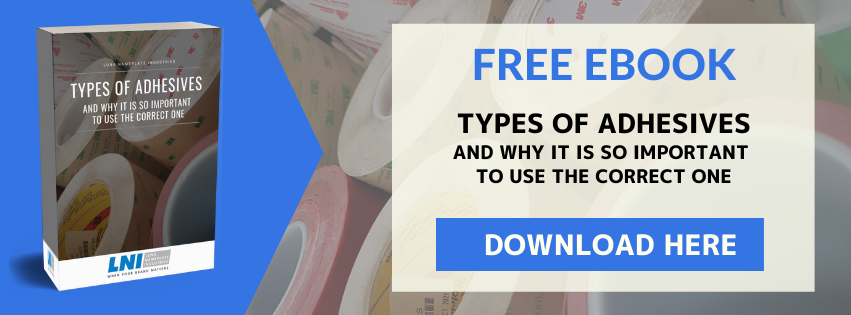
What is the most important feature of a nameplate, label or badge? (Spoiler – It’s the adhesive used)
An often-overlooked feature of a new nameplate, label or badge is also one of the most important. It is easy to get lost in beautiful designs that make your logo pop. After all, designing and then buying a new badge for a product can be an exciting time as it often means a new product launch is coming soon. However, all nameplates, badges and labels are required to serve a purpose that can’t be fulfilled if they’re falling off. Choosing the right adhesive is, therefore, one of the most important aspects when deciding on a branding solution.
When engaging in discussions with an expert in the field they should be asking the following questions to guide you to the best possible adhesive for your solution.
What surface is the badge or label being adhered to?
In a perfect labelling world, all surfaces would be the same. In reality, this is far from the truth. Knowing the surface that your label, nameplate or badge is to be adhered to is critical as every surface reacts differently with adhesives. 
For example, different plastics require different adhesives. Some plastics are what is known as Low Surface Energy or LSE. These plastics include polypropylene and polyethylene and require a very specific adhesive to ensure your label, nameplate or badge doesn’t fall off. Also, these plastics often have a texture, or ‘grain’, moulded into the surface which is a further consideration when selecting an adhesive.
Other plastics and surfaces, like ABS, polycarbonate, metal, Colourbond and glass usually require a different adhesive again.
Another tricky surface is powder coating. Don’t be fooled into thinking a basic vinyl sticker will adhere long-term to a powder-coated surface. It won’t.
LNI know this and therefore has a huge selection of adhesives from all the leading brands ensuring there will be at least one that is perfect for your label, nameplate or badge on your product.
Is your product likely to be in direct contact with water?
There is almost nothing better than an iced cold beer, straight from the esky. Have you ever noticed though that after time sitting in an esky and therefore in direct contact with water, the label will often fall off in your hand? This is a great example of the adhesive on the label not being properly-suited to direct contact with water.
It is possible to use adhesives that do not fail when they come into contact with water. This is not only vital for products that are to be submerged in water, but also any product that is likely to come into contact with rain.
The automotive industry does a great job of recognising this. How many car badges do you see fall off as soon as the rain hits? I’d be willing to bet it is not many, however other industries could certainly catch up.
Saltwater can also affect adhesives differently. It is important when deciding on a solution that this is considered. Imagine having labels falling off a brand-new boat. It’s not a very good look and can be easily avoided with some care.
Who is applying the solution and are they wearing gloves?
Often, and for good reason, employees in the manufacturing and assembly industries wear gloves on the factory floor. Believe it or not, this can cause problems for the adhesive. For example, wool-blend gloves will leave behind fibres that can impact the effectiveness of the adhesive.
LNI also understands that production lines can be fast-paced. Matching the adhesive method to the pace of the production line is important. For example, one adhesive method may take a couple of minutes, but a “peel and stick” solution may take a matter of seconds to apply. Having said this, it is more important to ensure that the adhesive lasts, which may impact application time.
Will the product be in direct sunlight?
This question is good practice regardless of the adhesive used. We all know UV light can damage products and lead to fading but it can also reduce the effectiveness of the adhesive. LNI has dealt with these issues in the past and has a wealth of experience supplying car manufacturers with labels, badges and emblems that are exposed to the sun all day.
Will the product be exposed to extreme temperatures?
If your product is exposed to extreme heat, such as in an industrial oven or near hot surfaces in a factory, the adhesive on the label may fail. This needs to be considered – especially when a solution becoming loose may lead to contamination of a product. Extremely cold temperatures can have a similar effect on the adhesive used which is something to think about too.
Extreme temperatures can affect more than just the performance of the adhesive too, so should be considered as part of the overall buying process.
If your current label, badge or emblem supplier is not asking these questions, your labels may be failing.
Speak to the specialists at LNI today to find a solution that will last longer than the product itself.
.svg)






